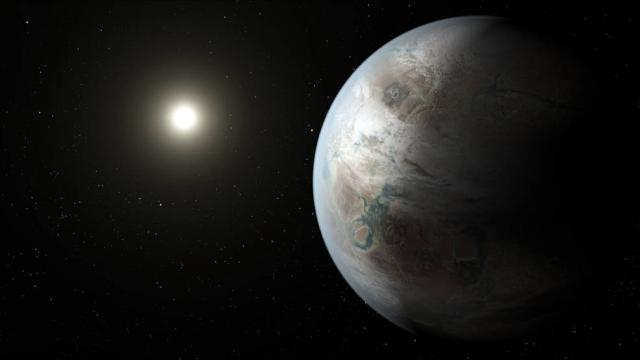Last week, the human race met its very first Earth-like planet orbiting a Sun-like star in the habitable zone. Kepler-452b’s discovery was met with resounding excitement, but the news was bittersweet. Because life on this distant world — if it exists at all — could be facing imminent extinction.
Earth’s new cousin has spent the last spent 6 billion-ish years in the habitable zone, but its ageing, brightening star could’ve already kickstarted a runaway greenhouse event, spelling the beginning of the end for complex life. In a billion years, a similar process will transform the Earth into a miserable wasteland.
Ageing is a natural step in planetary evolution, and it’s one that 452b might help us understand. To speculate about what’s going down on this distant world, scientists rely on what we know about how our own biosphere will die.
How the World Ends, According to Science
We all have our favourite doomsday scenario, from zombie viruses to giant asteroids to robot uprisings. But if none of these worthy apocalypses destroys the world first, there’s another Inevitable End: The slow extinction of Earth’s biosphere as the Sun bakes it dry.
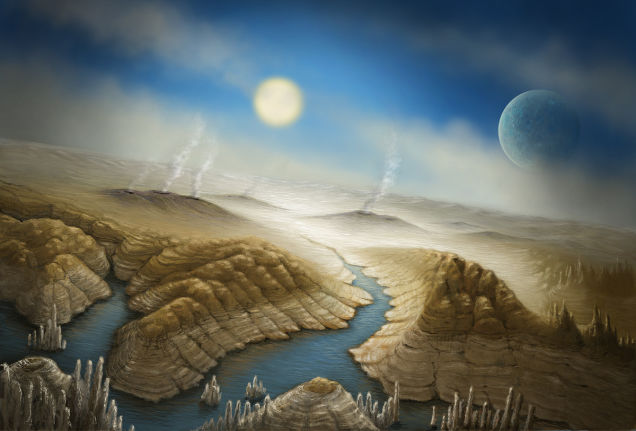
In 2012 and 2013, astrobiologist Jack O’Malley-James published a pair of scientific papers describing how the world as we know it will actually end in fascinating detail.* His analysis could apply to an Earthlike world like Kepler-452b, too.
Since its birth 4.5 billion years ago, the Sun’s luminosity has very slowly increased by about 30%, and it will continue growing brighter into the distant future. We’ll begin to feel the effects in about a billion years. At that point, the extra solar radiation will cause water to start rapidly evaporating off Earth’s surface. Water vapour acts as a heat-trapping greenhouse gas in the atmosphere, so widespread evaporation will kickstart a ‘runaway greenhouse,’ causing the Earth’s surface to warm even faster and evaporate even more.
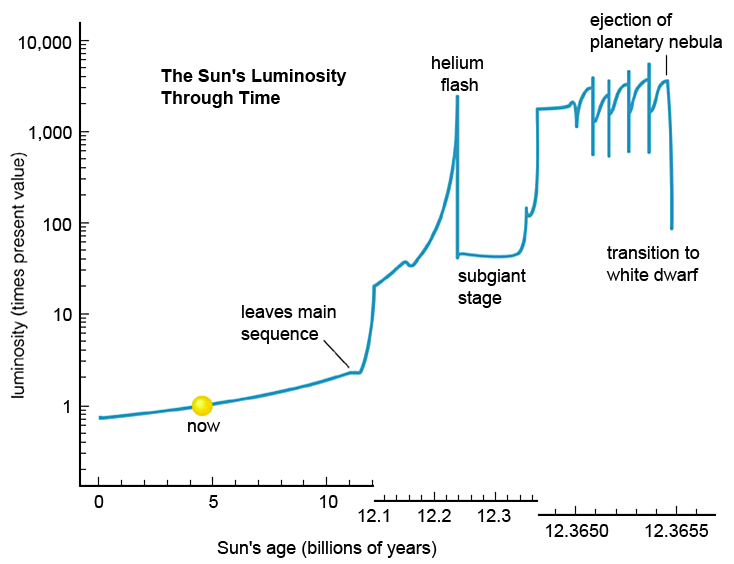
Solar luminosity over time, via Northwestern University
Higher temperatures will also increase the rate of silicate rock weathering in the Earth’s crust. As silicates weather, they suck carbon dioxide out of the atmosphere and lock it into certain kinds of rock. Normally, this isn’t an issue, because the loss of carbon is counterbalanced by tectonic activity like earthquakes and volcanism, which send carbon back into the atmosphere. But as Earth’s surface dries out, tectonic activity will slow and then cease. No more tectonics means no more geologic carbon cycle. At that point, atmospheric CO2 levels will start to plummet.
That will mark the beginning of the end for plants, which require CO2 for photosynthesis. Once atmospheric carbon levels fall below 10 parts per million (they’re currently just north of 400), pretty much all multicellular plant life will die gasping. And this is very bad news for the rest of us, because plants are not only the basis of Earth’s food webs, they replenish our oxygen supply. Atmospheric oxygen will enter free fall.
As the oxygen disappears, large animals will die off, followed by smaller ones. Insects and ocean invertebrates will probably hang on the longest. But within about 100 million years of the mass extinction of plants, animal life will also perish. At that point, Earth will once again become a world ruled by microbes.
Here’s a simple diagram illustrating the consequences of the most depressing future climate forecast ever:
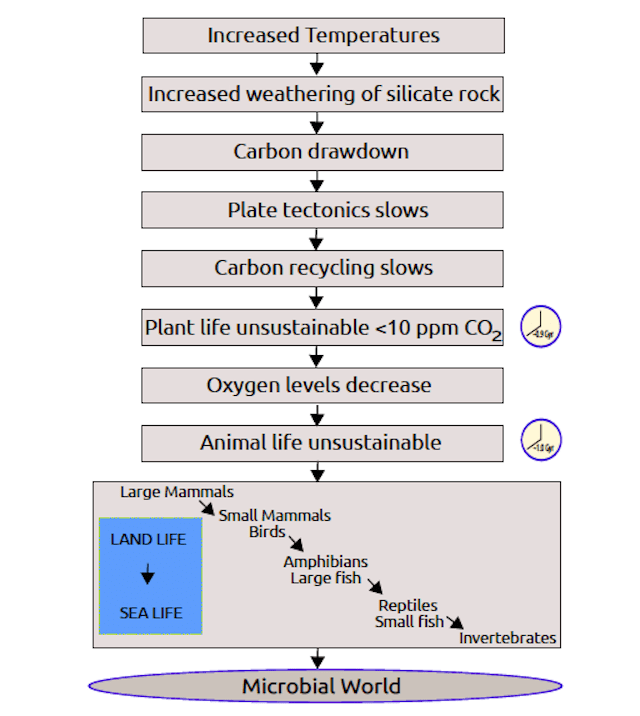
Image via O’Malley-James et al. 2012
In geologic terms, multicellular life will go quickly once certain key atmospheric gases get out of whack. But microbes are harder to kill. According to O’Malley-James, microorganisms could end up hanging on for more than a billion years after the extinction of complex life. As oceans of water pour into the atmosphere and Earth’s surface continues to cook, extremeophiles will retreat to caves, mountain peaks, ocean trenches — anywhere that they can escape the heat and find a little liquid water. 2.5 billion years in the future, O’Malley-James’ models predict, the last of Earth’s tenacious life forms will be staving off annihilation.
If future alien (or human) civilizations peer at the dying Earth through telescopes, they may detect the faintest traces of carbon dioxide and methane — the biological swansong of a once-vibrant planet. Three billion years from now, planet Earth will be completely sterilized.
A Galaxy of Dying Earths?
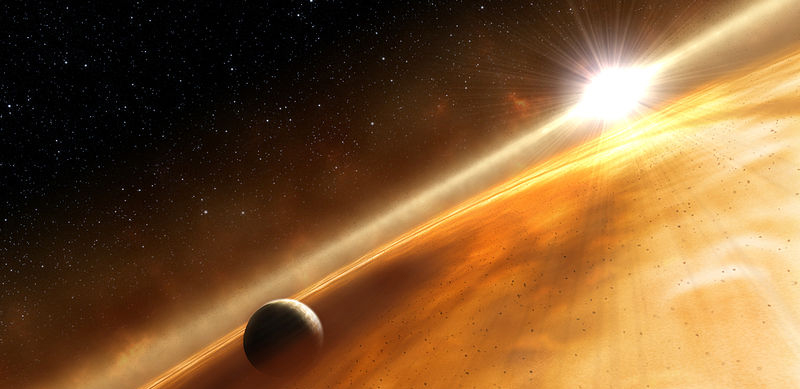
Artist’s concept of an exoplanet, via Wikimedia Commons
On geologic timescales, the window for complex life seems to be pretty short. A big question in astrobiology is whether the same holds true on other worlds.
So far, the evidence suggests that it probably will.
In another recent study, O’Malley-James and crew investigated the likelihood of finding a so-called ‘old-Earth-analogue’ — an ageing planet that can only support microbial life — in our stellar neighbourhood. Using climate models and planet frequency datasets, the team predicts there’s at least one such world within 100 parsecs of the solar system. Put another way, some 0.36% of the G-stars in our neighbourhood could harbour a planet in the final throws of an apocalypse. Assuming this rate holds for the entire galaxy, the Milky Way could be littered with thousands of dying Earths. According to model estimated rates of planet formation and stellar evolution, such worlds could outnumber human-friendly planets ten to one.
Put in that somewhat depressing context, we can count ourselves very lucky to have spotted 452b. While this planet is certainly getting old, it’s possible that complex life still has a little time.
Is Kepler-452b in Its Death Throes?
Kepler-452b is the closest Earth-analogue we’ve ever found. The planet has a radius 60% larger than ours, and it orbits a G2 star (the same type as our Sun) at an average distance of 1.05 AU. 452b’s star is roughly 20% larger, 10% brighter, and 1.5 billion years older than the Sun. As a result, despite having a slightly wider orbit, 452b receives approximately 10% more stellar radiation than the Earth.
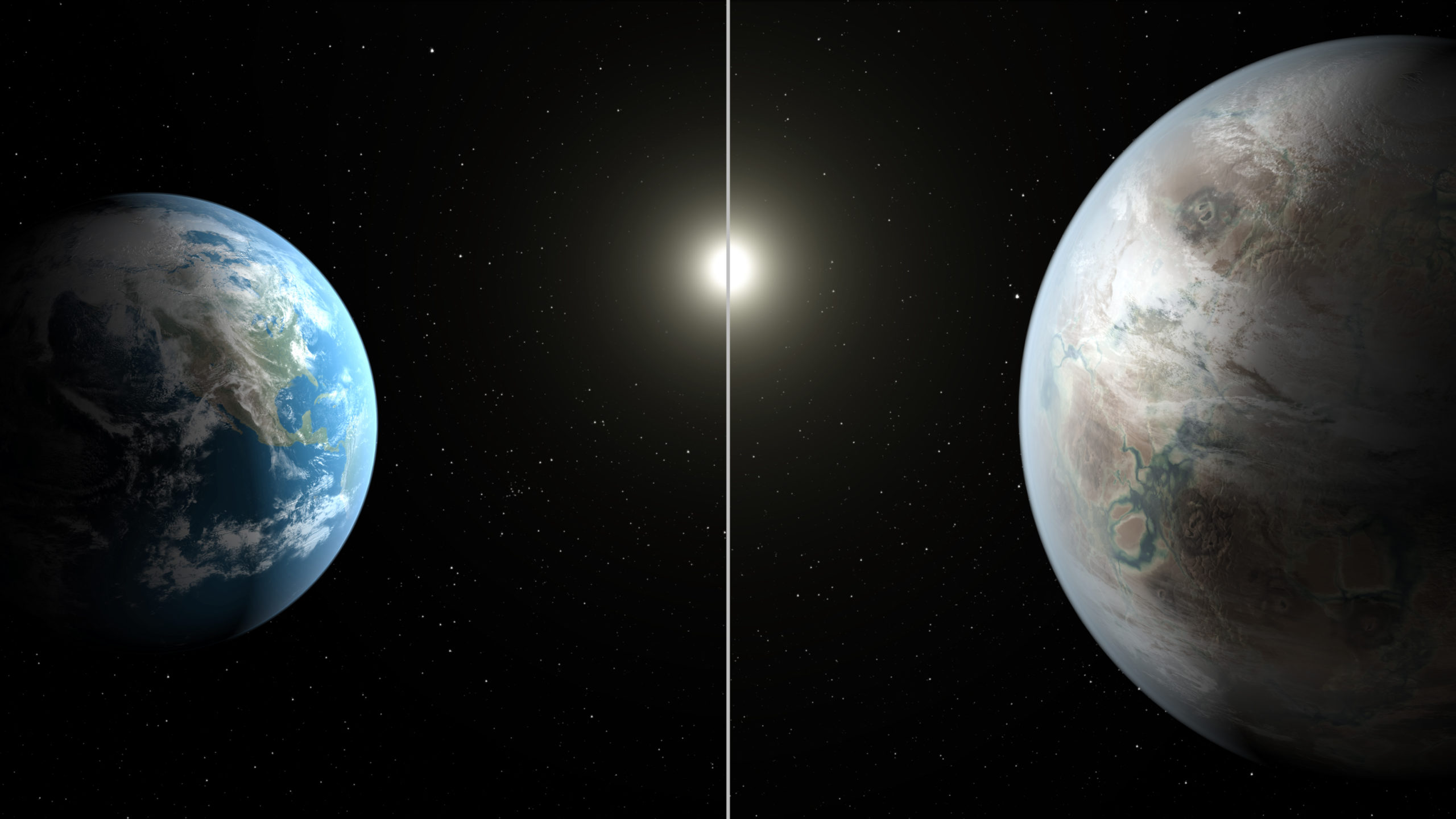
Artist’s concept compares Earth (left) to Kepler-452b, which is about 60 per cent larger in diameter. Image via NASA/JPL-Caltech/T. Pyle
Based on its relatively small size (it’s the smallest exoplanet planet to date discovered in the habitable zone), astronomers are estimating there’s a 49 — 62% chance the Kepler-452b is rocky. If it is a rocky world, it could look an awful lot like a bigger Earth, featuring a thick, cloudy atmosphere and active volcanoes.
But despite these tantalising hints of similarity, we can’t yet say for certain that this planet meets basic criteria for habitability. For one, without knowing 452b’s mass, we can’t calculate its density. There’s still a chance 452b is a gas world — a ‘mini-Neptune‘ rather than a ‘super-Earth’ — and if that were the case, it’d make the chances of life as we know it basically nil. Unfortunately, the planet is too distant and dim for astronomers to accurately measure its mass with current telescopes.
Even if Kepler-452b is rocky, it’s not yet clear whether the biochemistry that underpins the evolution of life would work on a planet with twice Earth’s gravity.
All of which is to say, while it may be the most Earth-like planet we know, we can only speculate about 452b’s prospects for life. Still, if we assume that it’s rocky, and that larger, heavier planets can support life, there’s very good reason to be excited about 452b, because this world has spent its entire lifetime inside the habitable zone of its star. As NASA’s Jon Jenkins noted in a press conference last week “that’s considerable time for life to arise somewhere on its surface or in its oceans should the conditions for life exist.”
Bill Moore, a planetary geologist at Hampton University, agrees. “Life seems to have emerged on the Earth very rapidly,” Moore told me over the phone. “Any life that might have gotten started on this planet has certainly had a long time to become complex.”
So, let’s be optimists for a moment and assume that life did evolve on 452b. How would the planet’s biosphere be faring today? The jury’s still out, but if 452b hasn’t already been hit by a runaway greenhouse event, that event is probably in the planet’s near future.
“If there is any kind of biosphere, it’s one that’s evolving to deal with progressively hotter and drier conditions,” Moore said.
Reason being, while Kepler-452b spent its first 5 billion years in the “conservative” habitable zone (indicated by the bright green band in the video above), the last 800 million-ish years have pushed this planet into the “optimistic habitable zone” of its star. Here, it’s susceptible to the sort of dramatic climate warming that Venus experienced in the past and that we expect to see on Earth in the future. Still, we don’t know how long it would take such a warming event to annihilate complex life, without knowing more about runaway greenhouses in general and 452b in particular.
“One of the open questions is: how much of a switch is a runaway greenhouse?” Moore said. “Is it a tipping point where, geologically speaking, you’re at Venus conditions in a short period of time? Or are there intermediate steps where it will hang out for a while? That’s something we don’t know. We don’t have a good enough handle on the way planets behave as they get hotter and hotter.”
O’Malley-James points out that since 452b is larger than Earth, it might be faring a little better than our Blue Marble would at the same life stage.
“If we assume that it [452b] is like Earth and that life there has a similar history to life on Earth, then it could be a good candidate for being a world that may once have hosted complex life, but now is better suited to microbes,” O’Malley-James told me in an email. “However, it could actually be a better place to live than Earth would be at that age. A more massive planet than Earth could hold on to its water for longer, delaying the runaway greenhouse effect. It could also be more volcanically active, which could super-charge the carbon cycle compared to Earth, meaning that the CO2 levels could stay stable for longer time periods, keeping conditions better for plants for longer and delaying the predicted sequence of extinction events.”
Bottom line is, we need more information about how runaway greenhouse events run their course in order to say whether 452b has already hit one. And that means we need to start looking at exoplanet atmospheres, which hide telltale signatures.
“Basically there are three different states a [Earth-like] world can be in,” Moore said. “It can be a snowball world, a world like the present day Earth, or a runaway greenhouse. We really don’t know how common these states are because we don’t have enough data on the atmospheres of planets.”
With the next generation of bigger, more powerful telescopes, we’ll be able to start catching the starlight reflected off the atmospheres of exoplanets and decoding their chemistry. The information we glean from afar will help scientists decipher what sort of an Earth-like planet — an icehouse, a hothouse, or a mild-weather world — we’re looking at.
“The presence of water is going to be a big one,” Moore said. “Beyond that, we’d love to see methane and CO2. All of those things would tell us the likelihood that we have evolved into a Venus state.”
For now, it seems safe to say that Kepler 452b — should it be rocky, should it have a biosphere — is at the very least beginning its slow slide toward complete extinction.
As bleak as that may sound, the possibility of any life at all on 452b is obviously very exciting. What’s more, finding a true “dying Earth analogue” would be a huge boon to planetary science. Studying such a planet would shed light on how our own planet’s carbon cycle and tectonic activity will change in the future.
Finally, there’s always the faint possibility that intelligent life emerged on 452b and made its escape long ago. Discovering any traces of an ancient, advanced civilisation would not only have profound implications for science, philosophy and religion, it would offer the human race hope that long-term survival — beyond the lifetime of one’s homeworld — might just be possible. Jenkins writes:
Until such time as other planets are discovered by other exoplanet surveys, or a SETI observation of this planetary system reveals signatures of extraterrestrial technologies, we are left to speculate on the fate of an ancient civilisation that may have developed first on Kepler-452b (or on a moon orbiting it). For example, it may have subsequently migrated to an as-yet-undetected outer planet to escape the inevitable loss of most of the intrinsic water inventory after the moist runaway greenhouse effect took hold at Kepler-452b’s orbital distance approximately 800 Myr ago.
As strange as it sounds, a dying Earth might actually be the most inspiring discovery the human race has ever made.
* Both papers are available in pre-print on arXiv and I encourage you to read them if you share my morbid obsession with the End Days.
Top image via NASA Ames/JPL-Caltech/T. Pyle
